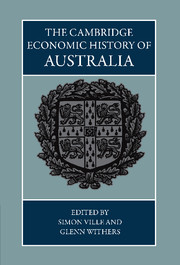Book contents
- The Cambridge Economic History of Australia
- The Cambridge Economic History of Australia
- Copyright page
- Contents
- Contributors
- List of figures
- List of maps
- List of tables
- Preface
- Abbreviations
- Introduction: connecting past, present and future
- Part 1 Framework
- Part 2 Transition
- Part 3 Economic expansion of the colonies
- 6 Technological change
- 7 Industrialising Australia’s natural capital
- 8 Labour, skills and migration
- 9 Colonial enterprise
- 10 Infrastructure and colonial socialism
- 11 Urbanisation
- Part 4 A national economy
- Part 5 Building the modern economy
- Part 6 Looking backwards and to the future
- Statistical Appendix: selected data series, 1800–2010
- References
- Subject index
- Company index
8 - Labour, skills and migration
from Part 3 - Economic expansion of the colonies
Published online by Cambridge University Press: 05 September 2014
- The Cambridge Economic History of Australia
- The Cambridge Economic History of Australia
- Copyright page
- Contents
- Contributors
- List of figures
- List of maps
- List of tables
- Preface
- Abbreviations
- Introduction: connecting past, present and future
- Part 1 Framework
- Part 2 Transition
- Part 3 Economic expansion of the colonies
- 6 Technological change
- 7 Industrialising Australia’s natural capital
- 8 Labour, skills and migration
- 9 Colonial enterprise
- 10 Infrastructure and colonial socialism
- 11 Urbanisation
- Part 4 A national economy
- Part 5 Building the modern economy
- Part 6 Looking backwards and to the future
- Statistical Appendix: selected data series, 1800–2010
- References
- Subject index
- Company index
Summary
Keywords
- Type
- Chapter
- Information
- The Cambridge Economic History of Australia , pp. 178 - 201Publisher: Cambridge University PressPrint publication year: 2014
- 3
- Cited by

